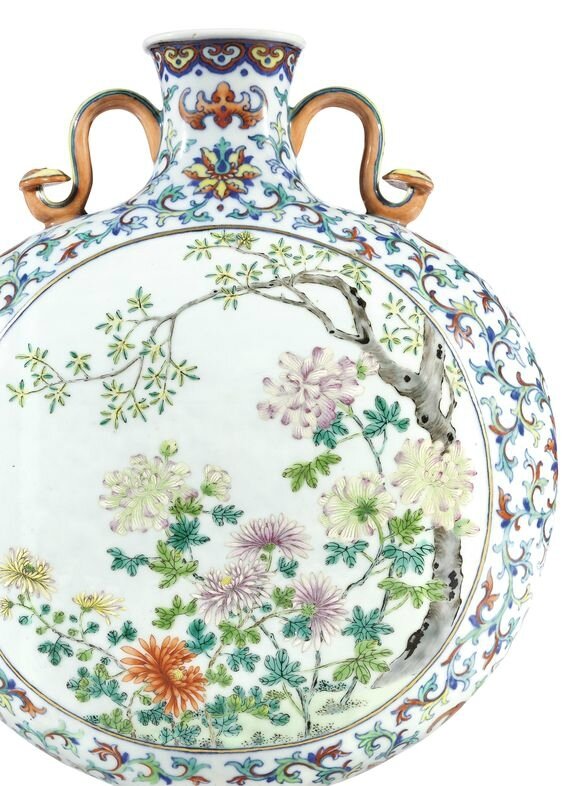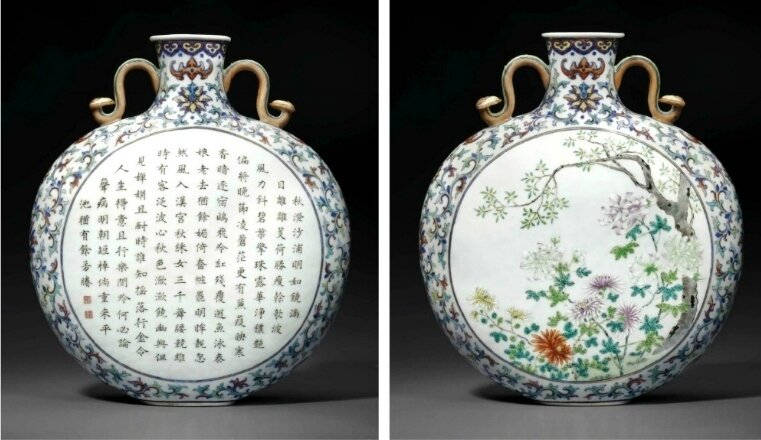A rare and brilliantly enamelled doucai and famille-rose inscribed ‘Autumn’ moonflask, seal mark and period of Qianlong
Lot 3615. A rare and brilliantly enamelled doucai and famille-rose inscribed ‘Autumn’ moonflask, seal mark and period of Qianlong (1736-1795), 31.8 cm, 12 1/2 in. Estimate 12,000,000 — 18,000,000 HKD. Lot sold 14,500,000 HKD. Photo: Sotheby's.
superbly modelled with a flattened globular body rising from a short unglazed foot to a waisted neck and lipped mouth-rim, the neck flanked by a pair of ruyi strap handles, each detailed with a yellow-ground band enclosing foliage and a floret, one side of the body decorated with a large gilt-rimmed medallion enclosing a famille-rose scene of an overhanging tree trunk and luxuriant flowering plants, including peony and chrysanthemum blooms, the reverse with a similarly gilt-rimmed medallion enclosing an imperial poem describing the autumnal floral scene and followed by two seal marks reading Qian and long respectively, the sides and neck of the vessel decorated in the doucai palette with bats and undulating lotus scrolls, the sides further detailed with ruyi heads interlinked with the foliate scrolls, all below a pendent ruyi border encircling the rim.
Provenance: Collection of Alfred Morrison (1821-1897), probably acquired in 1861 from Lord Loch of Drylaw (1827-1900).
Collection of the Rt. Hon the Lord Margadale of Islay, T.D., Fonthill House, Tisbury, Wiltshire.
Christie’s London, 18th October 1971, lot 95.
Collection of Mrs W.R. Bindley.
Sotheby's London, 16th June 1998, lot 289.
Note: This luxurious moonflask celebrates the creative breadth of porcelain production during the Qianlong period (1736-1795) and represents the Emperor’s personal taste which gravitated towards artistically complex designs. It is particularly notable for its successful incorporation of several design techniques on an early-Ming inspired form: a doucai formal scroll surrounding a famille-rose scene on one side and an inscription on the reverse, and shaped handles. By combining these different elements, the result is not only aesthetically striking but also draws attention to the Qianlong Emperor’s eclectic taste that shaped the development of porcelain during his reign.
An Exquisite Moonflask for Autumn
The eye is immediately drawn to the delicate medallion of flowers which have been elegantly rendered in famille-rose enamels and encircled with a fine gilt-painted line, correlating with the inscription on the reverse. In style, the rendering of the scene closely follows the flower paintings of one of China’s most eminent artists, Yun Shouping (1633-1690). Yun, whose sobriquet was Nantian, one of the ‘Six Masters’ of the early Qing period, generally associated with paintings of flowers in the meigu or ‘boneless’ style that emphasises washes of colour rather than lines. His novel and unique manner of painting allowed him to bring out the distinct and innate beauty of the flowers while making them appear vibrant. He reintroduced the use of strong, bold colours, such as reds, purples and bright greens, which helped revive this genre in China. Yun’s paintings were greatly admired by the Yongzheng (r. 1725-1736) and Qianlong Emperors, and with the development of famille-rose enamels in the 1720s, porcelain designs inspired by Yun’s paintings were created.
The overall design is flanked by a pair of ruyi-form handles, which adds an added dimension of novelty and opulence to the piece. The appearance of ruyi sceptres as handles on vases was clearly a response to the Qianlong Emperor’s predilection for the idiosyncratic. Combined with the lotus flowers and five red bats of the doucai scroll, they reveal the Qianlong Emperor’s infatuation with portents of good fortune, forming the wish for ‘longevity and fortune as high as the sky’.
A very small group of vessels of this attractive type that set a famille-rose scene within a doucai border is known and is so close in style, that they appear to have been created by the same hand; the companion to the present piece, sold in our London rooms, 14th November 2001, lot 116, and again at Christie’s New York, 15th/16th March 2015, lot 3160; and two vases in the Palace Museum, Beijing, illustrated in Yeh Pei-Lang, Gems of the Doucai, Taipei, 1993, pls 112 and 113. Characteristic of this group is the sense of harmony of that has been cleverly achieved through the use of iron-red and green enamel as a compositional device. By weaving these colours throughout the overall design, as seen in the ruyi handles and formal doucai lotus scroll to the large chrysanthemum bloom on the present piece, all the exquisitely rendered elements not only interact cohesively but complement each other.
A rare inscribed famille-rose and doucai moonflask, Qianlong period (1736-1795), . Sold for USD 365,000 at Christie’s New York, 15th/16th March 2015, lot 3160. © Christie’s Image Ltd 2015
Cf. my post: A rare inscribed famille rose and doucai moonflask, Qianlong period (1736-1795)
Further Qianlong mark and period vessels that combine doucai borders with famille-rose scenes, but painted in a different style, include a moonflask painted with bats, peaches, pomegranates and finger citrons and flanked by a pair of archaistic dragon handles, published in Geng Baochang, Ming Qing ciqi jianding [Appraisal of Ming and Qing porcelain], Hong Kong, 1993, fig. 478, and again in The Tsui Museum of Art. Chinese Ceramics IV: Qing Dynasty, Hong Kong, 1995, pl. 176, sold in these rooms, 8th November 1982, lot 204, and again at Christie’s Hong Kong, 8th October 1990, lot 525; and an ovoid vase, decorated with four famille-rose panels depicting flowers of the twelve months within raised borders of dense doucai foliate flower scrolls interspersed with ‘precious objects’, sold at Christie’s New York, 29th November 1990, lot 286. Compare also a doucai moonflask in the Tianjin Museum, illustrated in Gems of the Doucai, Taipei, 1993, pl. 116, painted with a figural scene in the centre surrounded by formal flower scrolls.
Sotheby's. Important Chinese Art, Hong Kong, 03 Oct 2017

/https%3A%2F%2Fprofilepics.canalblog.com%2Fprofilepics%2F1%2F0%2F100183.jpg)
/https%3A%2F%2Fstorage.canalblog.com%2F03%2F02%2F119589%2F96711876_o.jpg)
/https%3A%2F%2Fstorage.canalblog.com%2F11%2F31%2F119589%2F94773502_o.jpg)
/https%3A%2F%2Fstorage.canalblog.com%2F20%2F83%2F119589%2F94772815_o.jpg)
/https%3A%2F%2Fstorage.canalblog.com%2F26%2F72%2F119589%2F75604929_o.jpg)
/https%3A%2F%2Fstorage.canalblog.com%2F59%2F60%2F119589%2F26458628_o.jpg)







/image%2F1371349%2F20240402%2Fob_9318b6_130-1.jpg)
/image%2F1371349%2F20240402%2Fob_7227e1_129-1.jpg)
/image%2F1371349%2F20240402%2Fob_e7099e_128-1.jpg)
/image%2F1371349%2F20240401%2Fob_834d8f_telechargement.jpg)